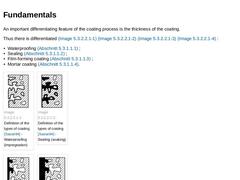
|
An important differentiating feature of the coating process is the thickness of the coating. Thus there is differentiated (Bild 5.3.1.1) (Bild 5.3.1.1) (Bild 5.3.1.1) (Bild 5.3.1.1) : - Waterproofing (Abschnitt 5.3.1.1.1) ;
- Sealing (Abschnitt 5.3.1.1.2) ;
- Film-forming coating (Abschnitt 5.3.1.1.3) ;
- Mortar coating (Abschnitt 5.3.1.1.4).
|
(Image: Definition of the types of coating [Sasse94] - Waterproofing (impregnation))
|
(Image: Definition of the types … |
|
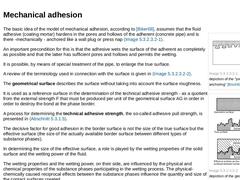
|
|
(Image: Schematic depiction of the "press nap anchoring" [Bisch82])
|
|
(Image: Schematic depiction of the geometric, true and effective surface [Sasse94])
|
|
(Image: Scale of roughness to [Seidl92])
|
The basic idea of the model of mechanical adhesion, according to [Biker68], assumes that the fluid adhesive (coating mortar) hardens in the pores and hollows of the adherent (concrete pipe) and is there -mechanically - anchored like a wall plug or press … |

|
|
(Image: Schematic depiction of the surface or border surface energies in wetting [Sasse94])
|
|
(Image: Critical surface energies in wetting [Zisma63])
|
The effective surface, as the sum of the contact surfaces between adhesive and solids, is the result of the wetting process. Under wetting (also dissemination) there is understood to include the adsorption and spreading of a fluid on a solid surface. Young [Young05] first reported on wetting experiments … |
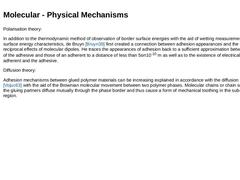
|
Polarisation theory: In addition to the thermodynamic method of observation of border surface energies with the aid of wetting measurements and border surface energy characteristics, de Bruyn [Bruyn39] first created a connection between adhesion appearances and the electrical reciprocal effects of molecular dipoles. He traces the appearances of adhesion back to a sufficient approximation between molecules of the adhesive and those of an adherent to … |
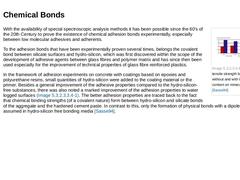
|
(Image: Adhesive tensile strength between coatings without and with hydro-silicon content on mineral base [Sasse94]) With the availability of special spectroscopic analysis methods it has been possible since the 60's of the 20th Century to prove the existence of chemical adhesion bonds experimentally, especially between low molecular adhesives and adherents. To the adhesion bonds that have been experimentally proven several times, belongs the covalent … |
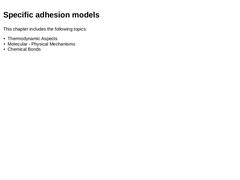
|
|
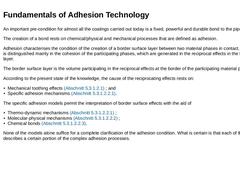
|
An important pre-condition for almost all the coatings carried out today is a fixed, powerful and durable bond to the pipe concrete. The creation of a bond rests on chemical/physical and mechanical processes that are defined as adhesion. Adhesion characterises the condition of the creation of a border surface layer between two material phases in contact. This condition is distinguished mainly in the cohesion of the participating phases, which are generated … |
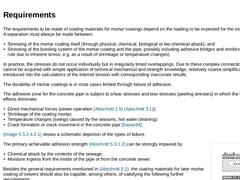
|
The requirements to be made of coating materials for mortar coatings depend on the loading to be expected for the individual case. A separation must always be made between: - Stressing of the mortar coating itself (through physical, chemical, biological or bio-chemical attack); and
- Stressing of the bonding system of the mortar coating and the pipe, possibly including adhesive bridges and reinforcement (as a rule due to inherent stress, e.g. as a result …
|
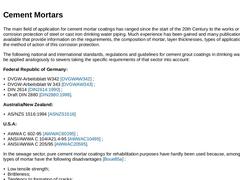
|
The main field of application for cement mortar coatings has ranged since the start of the 20th Century to the works or in-situ applied corrosion protection of steel or cast iron drinking water piping. Much experience has been gained and many publications are available that provide information on the requirements, the composition of mortar, layer thicknesses, types of application as well as the method of action of this corrosion protection. |
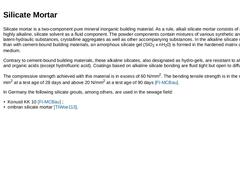
|
Silicate mortar is a two-component pure mineral inorganic building material. As a rule, alkali silicate mortar consists of a modified, highly alkaline, silicate solvent as a fluid component. The powder components contain mixtures of various synthetic and natural latent-hydraulic substances, crystalline aggregates as well as other accompanying substances. In the alkaline silicate mortars, other than with cement-bound building materials, an amorphous … |
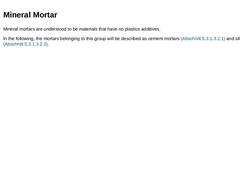
|
Mineral mortars are understood to be materials that have no plastics additives. In the following, the mortars belonging to this group will be described as cement mortars (Abschnitt 5.3.1.3.2.1) and silica mortars (Abschnitt 5.3.1.3.2.2). |
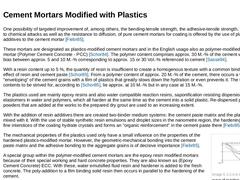
|
One possibility of targeted improvement of, among others, the bending-tensile strength, the adhesive-tensile strength, the resistance to chemical attacks as well as the resistance to diffusion, of pure cement mortars for coating is offered by the use of plastics additives to the cement mortar [Fiebr85]. These mortars are designated as plastics-modified cement mortars and in the English usage also as polymer-modified cement mortar (Polymer Cement Concrete - … |
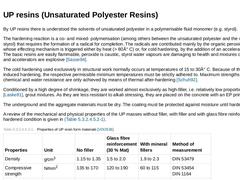
|
By UP resins there is understood the solvents of unsaturated polyester in a polymerisable fluid monomer (e.g. styrol). The hardening reaction is a co- and mixed- polymerisation (among others between the unsaturated polyester and the vulcanised styrol) that requires the formation of a radical for completion. The radicals are contributed mainly by the organic peroxides (hardener) whose effecting mechanism is triggered either by heat (> 80° C) or, for … |
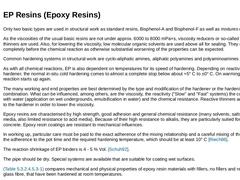
|
Only two basic types are used in structural work as standard resins, Bisphenol-A and Bisphenol-F as well as mixtures of the two. As the viscosities of the usual basic resins are not under approx. 6000 to 8000 mPa×s, viscosity reducers or so-called reactive thinners are used. Also, for lowering the viscosity, low molecular organic solvents are used above all for sealing. They must soften completely before the chemical reaction as otherwise substantial … |
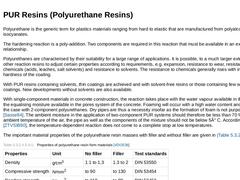
|
Polyurethane is the generic term for plastics materials ranging from hard to elastic that are manufactured from polyalcohols and poly-isocyanates. The hardening reaction is a poly-addition. Two components are required in this reaction that must be available in an exact mixture relationship. Polyurethanes are characterised by their suitability for a large range of applications. It is possible, to a much larger extent than with other reaction resins … |
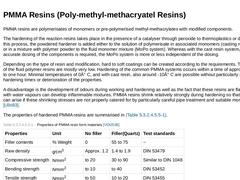
|
PMMA resins are polymerisates of monomers or pre-polymerised methyl-methacrylates with modified components. The hardening of the reaction resins takes place in the presence of a catalyser through peroxide to thermoplastics or duromers. In this process, the powdered hardener is added either to the solution of polymerisate in associated monomers (casting resin system) or in a mixture with polymer powder to the fluid monomer mixture (MoPo system). Whereas … |
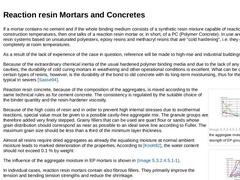
|
If a mortar contains no cement and if the whole binding medium consists of a synthetic resin mixture capable of reaction at the usual construction temperatures, then one talks of a reaction resin mortar or, in short, of a PC (Polymer Concrete). In use are reaction resin systems based on unsaturated polyesters, epoxy resins and methacryl resins that are "cold hardening", i.e. they can harden completely at room temperatures. As a result of the lack … |
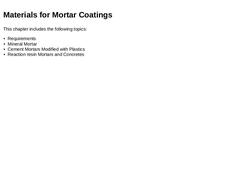
|
|
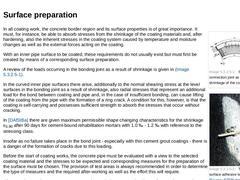
|
|
(Image: Stresses in the connection joint as a result of shrinkage of the coating [Schmi86])
|
|
(Image: Testing the surface adhesive tensile strength - Fixing the test block)
|
|
(Image: Testing the surface adhesive tensile strength - Tearing the test block off)
|
|
(Image: Testing the surface adhesive tensile strength - Test block after testing)
|
|
(Image: Concrete surface on inside of pipe prepared for application of coating (2 x sand blasting and 2 … |
|
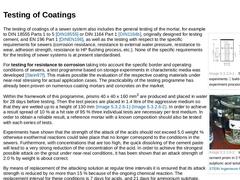
|
|
(Image: Storage experiments – build-up of experiment process [Stein97f])
|
|
(Image: Immersing a cement prism in 2 % weight sulphuric acid solution)
|
The testing of coatings of a sewer system also includes the general testing of the mortar, for example to DIN 18555 Parts 1 to 5 [DIN18555] or DIN 1164 Part 1 [DIN1164b], originally designed for testing cement, and EN 196 Part 1 [DINEN196], as well as the testing with respect to the specific requirements … |
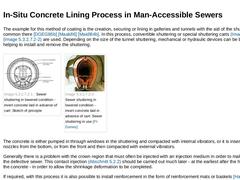
|
The example for this method of coating is the creation, securing or lining in galleries and tunnels with the aid of the shuttering common there [DGEG86b] [Maak86] [Maidl84b]. In this process, convertible shuttering or special shuttering carts (Bild 5.3.1.6.1) (Bild 5.3.1.6.1) are used. Depending on the size of the tunnel shuttering, mechanical or hydraulic devices can be built in for helping to install and remove the shuttering. |
(Image: Sewer shuttering … |
|
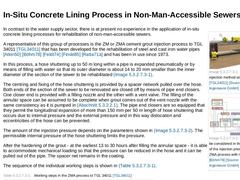
|
|
(Image: Cement grout injection method with reference to [TGL34011] [Image: S&P GmbH])
|
|
(Image: Influences to be considered in the determination of the injection pressure in the ZMA process with reference to [Böhm78] [Image: S&P GmbH])
|
In contrast to the water supply sector, there is at present no experience in the application of in-situ concrete lining processes for rehabilitation of non-man-accessible sewers. A representative of this group of … |
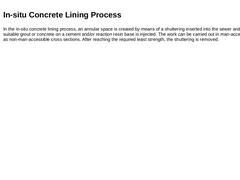
|
In the in-situ concrete lining process, an annular space is created by means of a shuttering inserted into the sewer and into this a suitable grout or concrete on a cement and/or reaction resin base is injected. The work can be carried out in man-accessible as well as non-man-accessible cross sections. After reaching the required least strength, the shuttering is removed. |
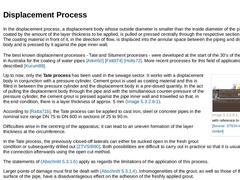
|
In the displacement process, a displacement body whose outside diameter is smaller than the inside diameter of the pipe to be coated by the amount of the layer thickness to be applied, is pulled or pressed centrally through the respective section of the sewer. The coating material in front of it, in the direction of flow, is displaced into the annular space between the piping and displacement body and is pressed by it against the pipe inner wall.… |
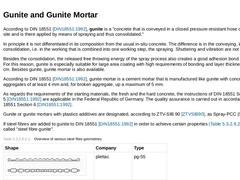
|
According to DIN 18551 [DIN18551:1992], gunite is a "concrete that is conveyed in a closed pressure-resistant hose or pipe to the site and is there applied by means of spraying and thus consolidated." In principle it is not differentiated in its composition from the usual in-situ concrete. The difference is in the conveying, insertion and consolidation, i.e. in the working that is combined into one working step, the spraying. Shuttering and vibration … |